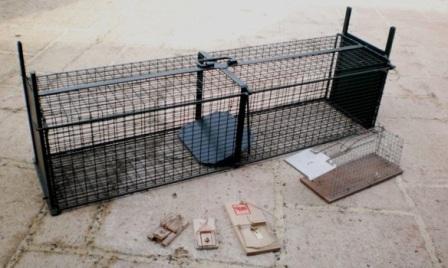We are only talking about simple and effective traps or snares. They were / are used by poachers and trappers. Snares are illegal in most countries.
The trap or snare has to catch an animal, to hold it or kill it.
The strength of a trap or snare comes from gravity or a spring, the tension of a curved branch or tree.
Put a trap or snare never too close to a den or watering hole, in those places an animal is extra alert. It will take a different route or way out in case of trouble.
Disturb the environment as little as possible. Let minimize odors behind. Step out on the trail. Make the trap or snare in a different place, but with material from the environment.
Touch as little as possible the components of a fall with your bare hands. If necessary, use gloves, rub your hands and objects with earth or mud.
 It makes no sense to place traps at random. Search for a track, a route that is followed by the prey. Early in the morning, when the sun rises, you will easily detect them in the dewy grass. Find a place where the path narrows and can be made smaller (a hole through a hedge) and is difficult to deviate. Possibly create your own channel or funnel-shaped barrier that leads to the trap or snare. Use fallen branches, so it does not stand out. If necessary, wait a few days until the prey is habt to the new situation.
It makes no sense to place traps at random. Search for a track, a route that is followed by the prey. Early in the morning, when the sun rises, you will easily detect them in the dewy grass. Find a place where the path narrows and can be made smaller (a hole through a hedge) and is difficult to deviate. Possibly create your own channel or funnel-shaped barrier that leads to the trap or snare. Use fallen branches, so it does not stand out. If necessary, wait a few days until the prey is habt to the new situation.
Camouflage the trap. Brush pale tips of cut branches with mud from the area. Do not use live plants that smell too strong.
Create a strong fall, a captive animal will use all his strength to get away.
The use of bait makes the chances of success greater.
Check traps and snares often. There are probably rivals in the field. And the catch should not suffer unnecessarily long.
Watch out, you would not be the first to fall in his own trap.
Hunting as a sport is criminal. Hunting is not out of need. The only legitimate hunter is the poacher. (Victor Hugo)
